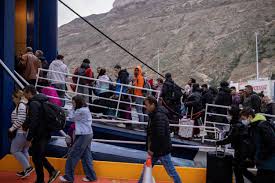
Thousands leave as seismic activity raises fears of a major earthquake
Hundreds more people were expected to leave Greece’s Santorini island on Wednesday as tremors continued to shake the popular tourist destination for the sixth consecutive day. The ongoing seismic activity has raised concerns over a potential major earthquake, prompting authorities to introduce precautionary measures.
Mass Evacuation Underway
According to officials, around 6,000 people have already departed the island via ferries and planes in recent days. The quakes, originating in the surrounding sea, have caused buildings to shake and dust to rise from Santorini’s rocky cliffs, further intensifying concerns.
Santorini, known for its iconic white-washed villas and picturesque landscapes, sees a surge in population during the summer months as millions of tourists visit. However, the island’s permanent population, as recorded in the 2021 census, is approximately 15,000. Given that it is currently the off-season, several thousand people are still believed to be on the island.
Authorities Implement Safety Measures
In response to the ongoing tremors, local authorities have implemented several safety measures, including:
- Suspending all construction activities.
- Closing schools on Santorini and nearby islands such as Ios, Amorgos, and Anafi.
- Monitoring seismic activity closely to assess further risks.
Despite these measures, three ferry routes between the port of Piraeus and Santorini were canceled on Wednesday due to rough sea conditions. However, Aegean Airlines confirmed that six flights, including two emergency evacuations, would proceed as planned.
Seismic Activity Continues, But Signs of Subsiding
Seismologists have cautioned that the heightened seismic activity could persist for days or even weeks. However, locals and government officials noted that the intensity of tremors had slightly reduced on Wednesday.
“It has not shaken much today. I haven’t felt anything since 4:00 AM,” said Nikos Sakorafos, a travel agency owner in the popular tourist village of Fira. “Now, it’s a dead season for the island. Most people don’t have work, so it’s easier for them to leave.”
Government to Issue Official Briefing
Greek government officials are expected to provide an update on the situation later on Wednesday. Greece is one of Europe’s most earthquake-prone countries due to its position at the boundary of the African and Eurasian tectonic plates.
Santorini, in particular, has a history of intense geological activity. The island took its current shape following a massive volcanic eruption around 1600 BC—one of the largest in recorded history. The most recent eruption in the area occurred in 1950.
As authorities continue to monitor the situation, residents and tourists remain on high alert, with many opting to leave the island until the seismic activity subsides.
Sources By Agencies


